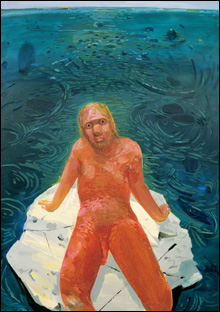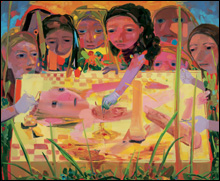 Back in 2001, the artist Dana Schutz had the deliciously harebrained idea to paint “The Last Man on Earth.” She christened him Frank, invented a tropical wilderness, marooned him there, and, figuring herself “The Last Artist on Earth,” began to paint him “from observation.”
Back in 2001, the artist Dana Schutz had the deliciously harebrained idea to paint “The Last Man on Earth.” She christened him Frank, invented a tropical wilderness, marooned him there, and, figuring herself “The Last Artist on Earth,” began to paint him “from observation.”
Frank, as Schutz imagined him, is a stoned dope, sunburned pink (with glops of paint congealed here and there like scabs) with a pig nose, chapped lips, stringy yellow hair and beard, eyes zonked out in an ignorance-is-bliss stupor. He saunters everywhere naked, with a respectable schlong. He’s a bit like the Tom Hanks character in Cast Away but he’s not doing nearly as well. The longer you stare at these paintings, the more Frank seems tired, beat. Something’s not right. The more you look, the more you worry about the poor guy.

Previously Schutz had painted goofy portraits, pictures of mannequins, the insides of made-up terrariums, and hapless sculptures based on descriptions friends told her about works they’d made in school (“the death of rock and roll” symbolized by a papier-mâché cockroach spiked onto a phonograph). The ones I’ve seen reproduced were okay. But this Frank thing, all zany hokum, seemed to unleash her imagination and ground her work. Her technique wasn’t all that different (and it’s only gotten better since), but it gave her something to chew on, namely the End of the World.
A lot of us were thinking about the end of the world right about then, after September 11. And such thoughts continue to color our lives, even if it’s only the blurry background. Schutz listens to reports of war and calamity around the globe on NPR as she mixes her colors, and then rock and hip-hop as she paints — of late the Sugarhill Gang. The 20 works curator Raphaela Platow has collected for “Dana Schutz: Paintings 2002–2005” at Brandeis’s Rose Art Museum are Goya’s Disasters of War in cheerful Starburst candy colors.
Schutz jetted in from her Brooklyn home to help with the hanging. Her buzz precedes her — the New York Times throws around phrases like “art star” and “one of the most sought-after artists of her generation.” I found the 29-year-old, a slender woman with wavy brown hair, in a back room rummaging through the museum’s collection, looking for inspiration. Her best paintings charm with hot, emotionally charged colors, jaunty arrays of shapes, blissful disregard for proper anatomy, and brisk, loose brushwork. And though she talks about distorting perspective and flattening the picture plane and other meaty formal considerations, she never seems to take it all that seriously. A painting of Frank wandering absent-mindedly through a broad-leafed jungle features nipples erected of two squirts of paint that poke out half an inch. Another canvas is marked here and there by round gobs of paint that Schutz hurled across her studio to see what would stick.
Back in September 2001, while working toward a master’s degree in fine arts at Columbia, Schutz went to meet one of her teachers. She’d gotten a copy of The Worst-Case Scenario Survival Handbook, and they discussed her idea to take the book’s diagrams — like instructions on how to fight a bear — and elaborate on them in her paintings. “That was on September 10, and it really changed the next day. I had these ideas before, but . . . ”
As the Frank paintings progressed, she’d dismantle her Frank-enstein man and reassemble his parts as a morbid still life (Night in Day) or as a pathetic flesh-mud-and-stick re-creation of rockers Kim and Kelley Deal out in the woods somewhere (The Breeders). The Deal sisters and a tall painting of PJ Harvey (50 Foot Queenie), her arms like wads of gum stuck together, her legs frail sticks jammed into red stiletto heels, suggest someone stranded without her iPod in the middle of nowhere trying to soothe herself by conjuring her favorite tunes.
 This in turn led to Schutz’s series of Self-Eater paintings, in which bug-eyed characters devour themselves. In Devourer, a woman’s panicked nailbiting has gone horribly awry and she’s gnawing off her fingers, blood dripping down her arms. In New Legs, a nude blonde has lost her legs (“she ate them”) and is molding herself replacements out of mud or (her?) shit. In Happy, a blonde’s nude torso has been turned to Swiss cheese and her long E.T. fingers bent in painful directions. Schutz sees these auto-cannibals as regenerative, devouring or sacrificing parts of themselves to build anew, to “self-improve.” But I can’t get past the eyes — they’re fey, shell-shocked. They’re happy only because they’re not feeling anything.
This in turn led to Schutz’s series of Self-Eater paintings, in which bug-eyed characters devour themselves. In Devourer, a woman’s panicked nailbiting has gone horribly awry and she’s gnawing off her fingers, blood dripping down her arms. In New Legs, a nude blonde has lost her legs (“she ate them”) and is molding herself replacements out of mud or (her?) shit. In Happy, a blonde’s nude torso has been turned to Swiss cheese and her long E.T. fingers bent in painful directions. Schutz sees these auto-cannibals as regenerative, devouring or sacrificing parts of themselves to build anew, to “self-improve.” But I can’t get past the eyes — they’re fey, shell-shocked. They’re happy only because they’re not feeling anything.